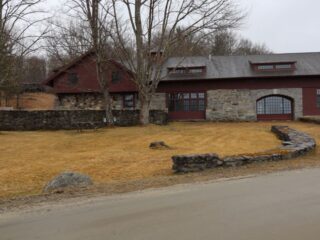by Kathryn Yelinek
Like any good mystery writer, Gaston Leroux builds his novels in layers. On one layer, his The Phantom of the Opera is a tragic love story about the reclusive, deformed Erik’s obsession for the opera singer Christine Daae. But on the other layer, the book is a celebration of a particular city, Paris, and a particular building, the Paris Opera House. When I visited Paris one hot week in June, I made a pilgrimage to many of the locales mentioned in the book. This journey through Paris took me from the cool, shadowed sidewalks of a medieval street to the haughty decadence of the Opera’s Grand Staircase. I had visited the City Of Lights as a child and read The Phantom of the Operamany times since then, so I had already created images of these places that were only reinforced and magnified by my new first-hand experience. And as my week in Paris played out, I treated myself to reading Leroux’s novel in French in the setting that first brought the story to life.
I began my journey at the heart of the book, the Paris Opera House. Also named the Opera Garnier after its architect Charles Garnier, it sits in the Place de l’Opera in Paris’s second arrondissement. It was commissioned in 1860 by the Emperor Napoleon III, nephew to Napoleon Bonaparte, after he narrowly escaped an assassination attempt at the former opera on the Rue Le Peletier. Construction dragged on through the Franco-Prussian War, the Siege of Paris, the Paris Commune, and the resulting Third Republic. The building finally received its inauguration on January 5, 1875, long after Napoleon III’s fall from power.
From the beginning, the architecture of the Opera drew puzzled comments and snide remarks–it has been compared to a Turkish bath and a labyrinth. One famous anecdote has the Empress Eugenie demanding of Garnier in what style he meant to build. Garnier replied, “In the Napoleon III style, Madame!” Without a doubt, the building possesses a hushed grandeur that comes from marble columns, stone mosaics, and bronze statues. The result is a gaudy jewel box dedicated to the musical arts, a fitting backdrop to Leroux’s romantic thriller.
The best way to approach the Opera is from the Avenue de l’Opera to the south. Here regulations cap the heights of neighboring buildings to create clean lines that draw the eye to the Opera. When I visited, the faade had just been unveiled after a cleaning, and the various whites and pinks of the marble shone in rich hues. Above the Opera, visible from the length of the Avenue, stands the statue of Apollo, flanked by the embodiments of Music and Poetry. It is here, at the apex of the Opera, that the Phantom Erik hears his beloved Christine make plans to elope with the aristocratic Viscount Raoul de Chagny.
One enters the Opera up a set of steps, past sculptured personifications of Instrumental Music, Lyric Drama, and La Danse, into a peristyle that leads to the Grand Staircase. Even in a building stuffed with sculptures and paintings, the Grand Staircase outshines them all for sheer lavishness. Leroux chose the Grand Staircase as the backdrop to one of the most dramatic scenes in his novel: the appearance at a Masked Ball of Erik dressed as the Red Death, trailing a cloak of red velvet. The Staircase itself, made of white marble steps and an onyx balustrade, rises to the door of the auditorium. At the foot of the staircase stand a pair of torcheres crafted by Carrier-Balleuse, who was Rodin’s master. On the balcony railings that overlook the staircase hang sculpted lyres, a motif repeated frequently throughout the Opera.
For a building the size of the Opera, with seventeen floors and layers upon layers of foyers, the auditorium seems small. In truth, although it seats only 2,200 patrons, and it occupies just under half the volume of the building. Prominent is the red and gold forecurtian lowered over the stage. Above the curtain are the date 1669 and an emblematic sun, commemorating the year in which the Sun King Louis XIV established the French National Academy of Music. All ornaments, columns, and caryatids in the auditorium, including the proscenium arch over the stage, are gilded or bronzed for an atmosphere of restrained brilliance. Such design recalls the era of the Opera’s beginnings, when the gas lights remained lit throughout every performance so the privileged in the audience could see and be seen.
Above the auditorium stretches the colorful ceiling painted by Marc Chagall. This ceiling, installed in 1964, pays homage to the festive atmosphere of the theater and covers the original Lenepveu ceiling of painted rays representing the sun and lightning. In the center hangs the famous (or infamous) chandelier. Weighing over six tons, the chandelier is reinforced by a system of counterweights. Still, Erik sends this chandelier crashing into the audience during a performance of Faust when the management refuses to cast Christine in the role of Marguerite. This fictional plot twist echoes a real incident from 1896, when one of the counterweights from the chandelier fell during a performance and killed a woman patron. The fertile mind of the reporter-writer Leroux would mix this tragedy into the drama that became The Phantom of the Opera.
To the left of the stage sits First Tier Box Five. Leroux tells us that Erik chose this box as his own. The box looks rather innocuous, not nearly as ostentatious as the neighboring Emperor’s box, which sits second from the stage. The view from Box Five is rather poor since part of the stage is obscured, but then the Phantom of the Opera concerned himself more with the quality of sound than with visual presentation. The box may be rented for performances as can any other seat in the auditorium, so the literary traveler may have the thrill of watching a show from the same perspective as the Opera Ghost.
On the eastern side of the Opera is the Subscriber’s Rotunda. This entrance, once reserved for wealthy season ticket holders, has since been closed. The ramp built for horse-drawn carriages remains, however, and here the Viscount de Chagny orders his carriage to wait to carry Christine away the night they mean to elope. On the opposite, western side of the Opera runs the Rue Scribe. This short street exists to connect the larger boulevards and to frame the Place de l’Opera. But Leroux tells the reader that the Rue Scribe gives access to a hidden gate that leads in turn to Erik’s secret underground house. Only Erik, and later Christine, holds the key to open the gate.
Of the other Parisian sites mentioned in The Phantom of the Opera, including the Bois de Bologne, the Rue du Faubourg-Saint-Honore, and the Gare de Montparnasse, two bear special mention and are within easy walking distance of the Opera. The first, the Rue Notre-Dame-des-Victoires, is reached by walking east from the Place de l’Opera to the Boulevard des Italiens and further still to the Boulevard Montmartre. Christine lives in a little apartment on this street with her widowed guardian, the elderly Mama Valerius. When the Viscount de Chagny calls there the morning after the Masked Ball, he finds Christine wearing the gold ring of another man, the mysterious Erik. The Rue Notre-Dame-des Victoires is a narrow street with slim sidewalks and buildings that front the pavement, a reminder of the medieval past of the city. The small Notre-Dame-des-Victoires church sits along the street, and a polite sign reminds tourists to respect the sanctity of the location. This street, reserved and quiet, contrasts with the bustling decadence of the Opera, just as Christine, a simple girl from rural Sweden, could have been no more different than the showy and worldly Erik.
In the opposite direction, the church of the Madeleine is found a short walk west of the Opera, down the Boulevard des Capucines to the Boulevard de la Madeleine. Unlike the other sites mentioned, no action in The Phantom of the Operatakes place at La Madeleine. Instead, it represents the impossible dream of Erik: to live like a normal person with a loving wife and a house above ground. As Christine tells the Viscount, after Erik abducts her he swears to destroy himself and the entire Opera if she does not wed him before a priest and the civil authorities in La Madeleine. The choice of La Madeleine has never made much sense to me, and the explanation that Leroux chose it simply because it is close to the Opera falls flat. The building itself strikes me as austere and cold. A strict rectangle, it is surrounded by columns like a Greek temple. The rigid geometry stands in contrast to the lavish, almost rambling design of the Opera. So too is Erik’s dream a cold impossibility next to the intricate kingdom he creates for himself in the Paris Opera. The one does not belong alongside the other.
Leroux opens and closes his book by insisting that Erik, the Phantom of the Opera, existed. While no one will see a figure in formal dress and a felt hat flitting through secret passages in the Opera, one can visit the haunts that inspired him as well as the countless books, movies, and theatrical productions that continue to retell his story. While some retellings may change Erik’s history (the silent movie with Lon Chaney or the musical Phantom by Maury Yeston and Arthur Kopit), the ultimate choice that Christine makes (the 1943 movie with Claude Rains), or the locale (the novel Night Music by Charlotte Vale Allen), the story forever retains the basic elements of an outcast hidden within a building as behind a mask, focusing all his attention on one impressionable young woman.








